MGT8022 - Project-Based Management: Analysis of Amalgamation Plan
VerifiedAdded on 2023/06/11
|18
|5301
|327
Report
AI Summary
This report provides a critical analysis of the project management plan (PMP) for the City of Swan and Shire of Mundaring amalgamation project, evaluating its alignment with the Guide to the Project Management Body of Knowledge (PMBOK Guide). The analysis covers key areas such as project scope management, cost management, procurement management, communication, scheduling, quality, risk, and human resources. The report identifies strengths and weaknesses in the PMP, noting areas where the plan aligns with PMBOK guidelines and areas needing improvement, such as life cycle costing, risk analysis, and inclusion of a project close-out phase. Specific recommendations are provided to enhance the PMP's effectiveness, ensuring better project outcomes. Desklib offers this report as a resource for students studying project management, along with a wealth of other solved assignments and study materials.

Project Management Plan
Paraphrase This Document
Need a fresh take? Get an instant paraphrase of this document with our AI Paraphraser
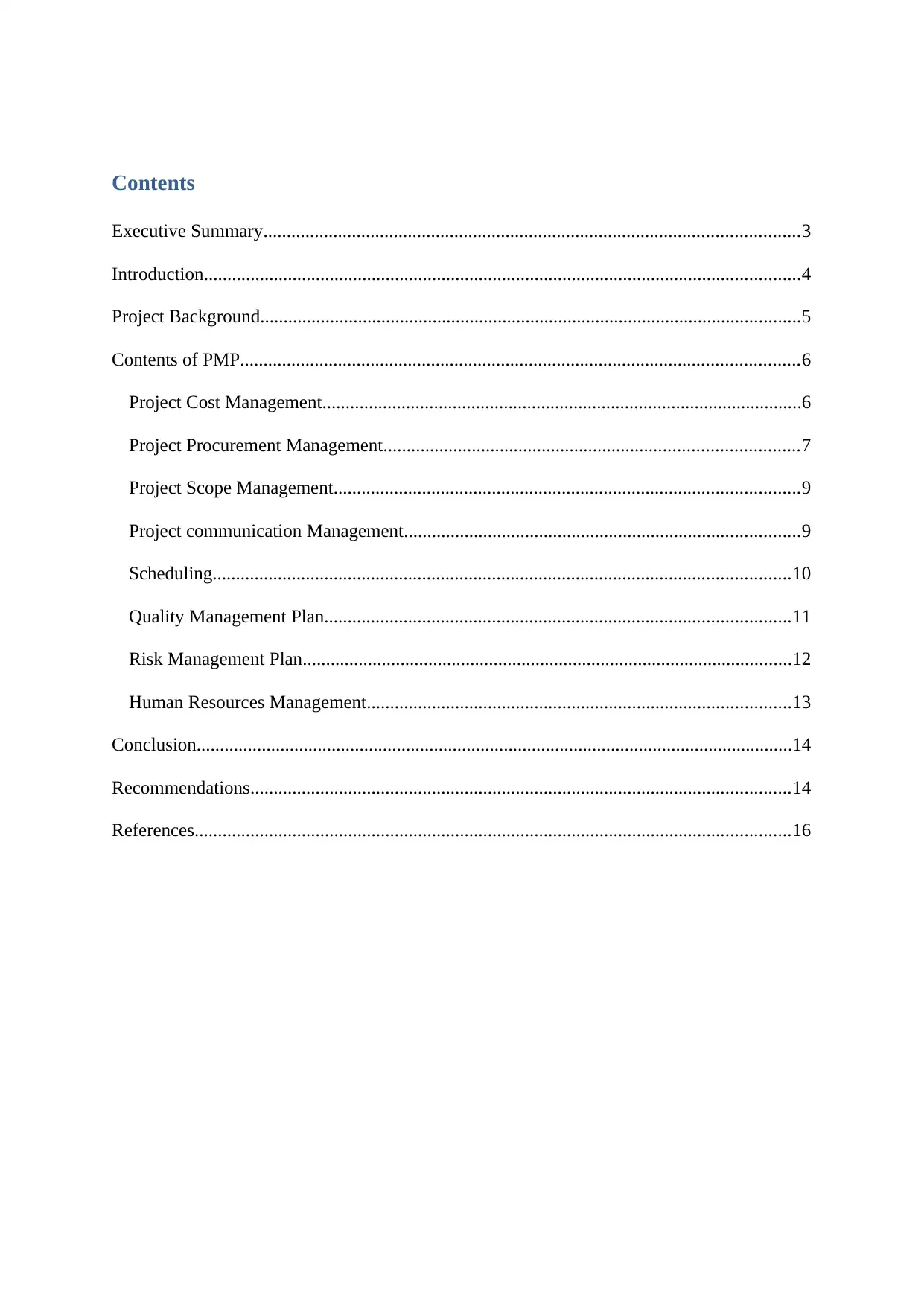
Contents
Executive Summary...................................................................................................................3
Introduction................................................................................................................................4
Project Background....................................................................................................................5
Contents of PMP........................................................................................................................6
Project Cost Management.......................................................................................................6
Project Procurement Management.........................................................................................7
Project Scope Management....................................................................................................9
Project communication Management.....................................................................................9
Scheduling............................................................................................................................10
Quality Management Plan....................................................................................................11
Risk Management Plan.........................................................................................................12
Human Resources Management...........................................................................................13
Conclusion................................................................................................................................14
Recommendations....................................................................................................................14
References................................................................................................................................16
Executive Summary...................................................................................................................3
Introduction................................................................................................................................4
Project Background....................................................................................................................5
Contents of PMP........................................................................................................................6
Project Cost Management.......................................................................................................6
Project Procurement Management.........................................................................................7
Project Scope Management....................................................................................................9
Project communication Management.....................................................................................9
Scheduling............................................................................................................................10
Quality Management Plan....................................................................................................11
Risk Management Plan.........................................................................................................12
Human Resources Management...........................................................................................13
Conclusion................................................................................................................................14
Recommendations....................................................................................................................14
References................................................................................................................................16
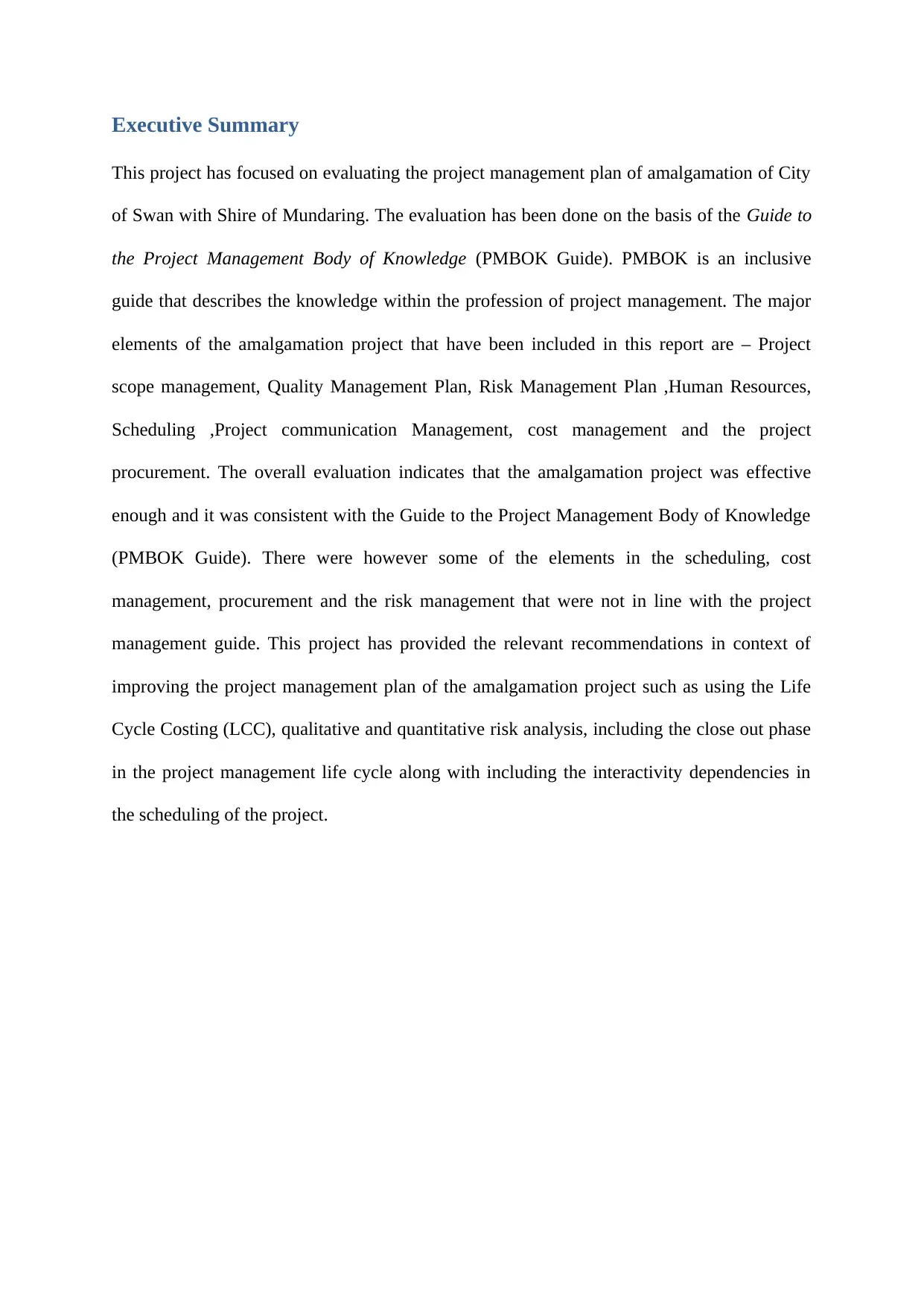
Executive Summary
This project has focused on evaluating the project management plan of amalgamation of City
of Swan with Shire of Mundaring. The evaluation has been done on the basis of the Guide to
the Project Management Body of Knowledge (PMBOK Guide). PMBOK is an inclusive
guide that describes the knowledge within the profession of project management. The major
elements of the amalgamation project that have been included in this report are – Project
scope management, Quality Management Plan, Risk Management Plan ,Human Resources,
Scheduling ,Project communication Management, cost management and the project
procurement. The overall evaluation indicates that the amalgamation project was effective
enough and it was consistent with the Guide to the Project Management Body of Knowledge
(PMBOK Guide). There were however some of the elements in the scheduling, cost
management, procurement and the risk management that were not in line with the project
management guide. This project has provided the relevant recommendations in context of
improving the project management plan of the amalgamation project such as using the Life
Cycle Costing (LCC), qualitative and quantitative risk analysis, including the close out phase
in the project management life cycle along with including the interactivity dependencies in
the scheduling of the project.
This project has focused on evaluating the project management plan of amalgamation of City
of Swan with Shire of Mundaring. The evaluation has been done on the basis of the Guide to
the Project Management Body of Knowledge (PMBOK Guide). PMBOK is an inclusive
guide that describes the knowledge within the profession of project management. The major
elements of the amalgamation project that have been included in this report are – Project
scope management, Quality Management Plan, Risk Management Plan ,Human Resources,
Scheduling ,Project communication Management, cost management and the project
procurement. The overall evaluation indicates that the amalgamation project was effective
enough and it was consistent with the Guide to the Project Management Body of Knowledge
(PMBOK Guide). There were however some of the elements in the scheduling, cost
management, procurement and the risk management that were not in line with the project
management guide. This project has provided the relevant recommendations in context of
improving the project management plan of the amalgamation project such as using the Life
Cycle Costing (LCC), qualitative and quantitative risk analysis, including the close out phase
in the project management life cycle along with including the interactivity dependencies in
the scheduling of the project.
⊘ This is a preview!⊘
Do you want full access?
Subscribe today to unlock all pages.

Trusted by 1+ million students worldwide
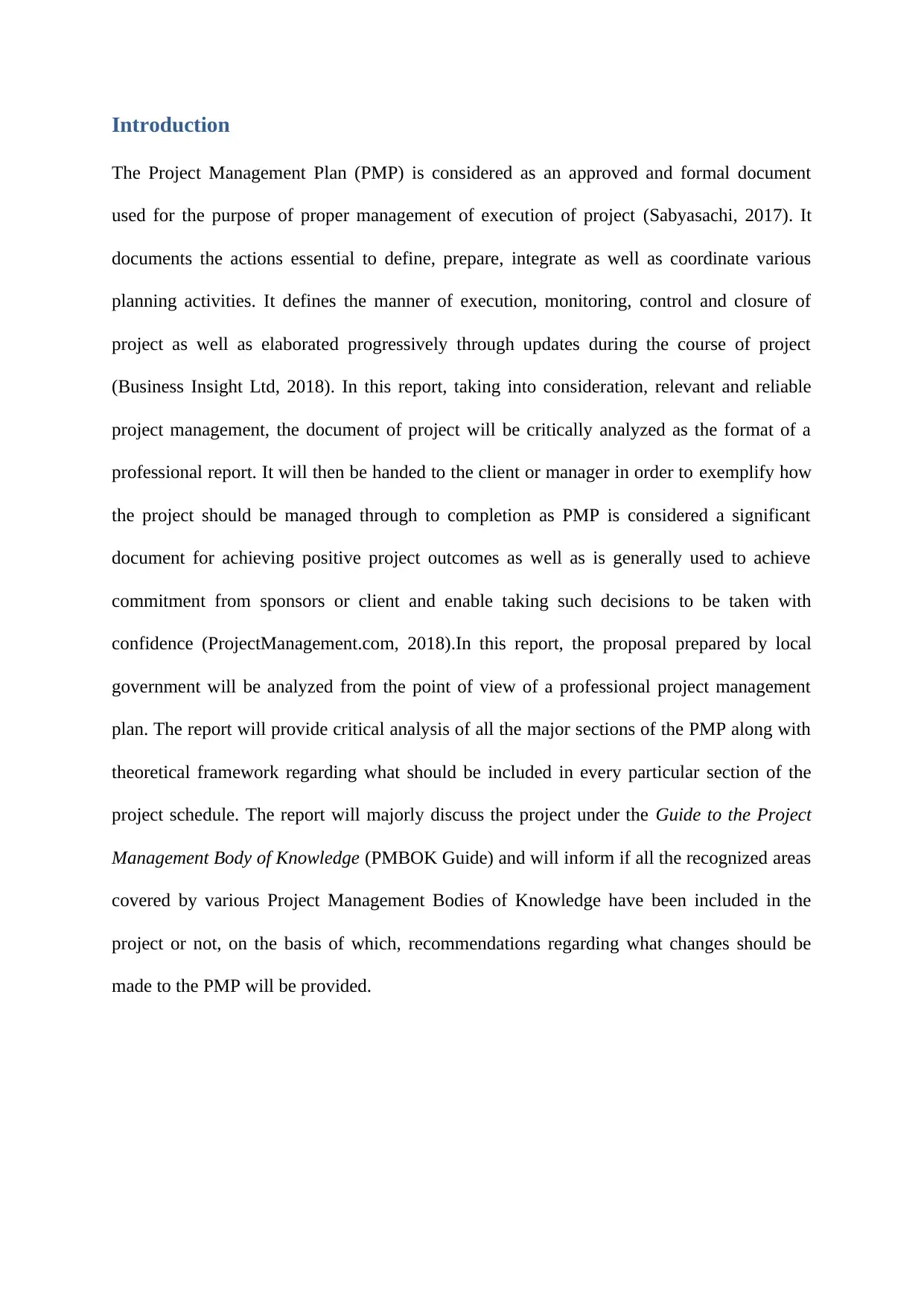
Introduction
The Project Management Plan (PMP) is considered as an approved and formal document
used for the purpose of proper management of execution of project (Sabyasachi, 2017). It
documents the actions essential to define, prepare, integrate as well as coordinate various
planning activities. It defines the manner of execution, monitoring, control and closure of
project as well as elaborated progressively through updates during the course of project
(Business Insight Ltd, 2018). In this report, taking into consideration, relevant and reliable
project management, the document of project will be critically analyzed as the format of a
professional report. It will then be handed to the client or manager in order to exemplify how
the project should be managed through to completion as PMP is considered a significant
document for achieving positive project outcomes as well as is generally used to achieve
commitment from sponsors or client and enable taking such decisions to be taken with
confidence (ProjectManagement.com, 2018).In this report, the proposal prepared by local
government will be analyzed from the point of view of a professional project management
plan. The report will provide critical analysis of all the major sections of the PMP along with
theoretical framework regarding what should be included in every particular section of the
project schedule. The report will majorly discuss the project under the Guide to the Project
Management Body of Knowledge (PMBOK Guide) and will inform if all the recognized areas
covered by various Project Management Bodies of Knowledge have been included in the
project or not, on the basis of which, recommendations regarding what changes should be
made to the PMP will be provided.
The Project Management Plan (PMP) is considered as an approved and formal document
used for the purpose of proper management of execution of project (Sabyasachi, 2017). It
documents the actions essential to define, prepare, integrate as well as coordinate various
planning activities. It defines the manner of execution, monitoring, control and closure of
project as well as elaborated progressively through updates during the course of project
(Business Insight Ltd, 2018). In this report, taking into consideration, relevant and reliable
project management, the document of project will be critically analyzed as the format of a
professional report. It will then be handed to the client or manager in order to exemplify how
the project should be managed through to completion as PMP is considered a significant
document for achieving positive project outcomes as well as is generally used to achieve
commitment from sponsors or client and enable taking such decisions to be taken with
confidence (ProjectManagement.com, 2018).In this report, the proposal prepared by local
government will be analyzed from the point of view of a professional project management
plan. The report will provide critical analysis of all the major sections of the PMP along with
theoretical framework regarding what should be included in every particular section of the
project schedule. The report will majorly discuss the project under the Guide to the Project
Management Body of Knowledge (PMBOK Guide) and will inform if all the recognized areas
covered by various Project Management Bodies of Knowledge have been included in the
project or not, on the basis of which, recommendations regarding what changes should be
made to the PMP will be provided.
Paraphrase This Document
Need a fresh take? Get an instant paraphrase of this document with our AI Paraphraser
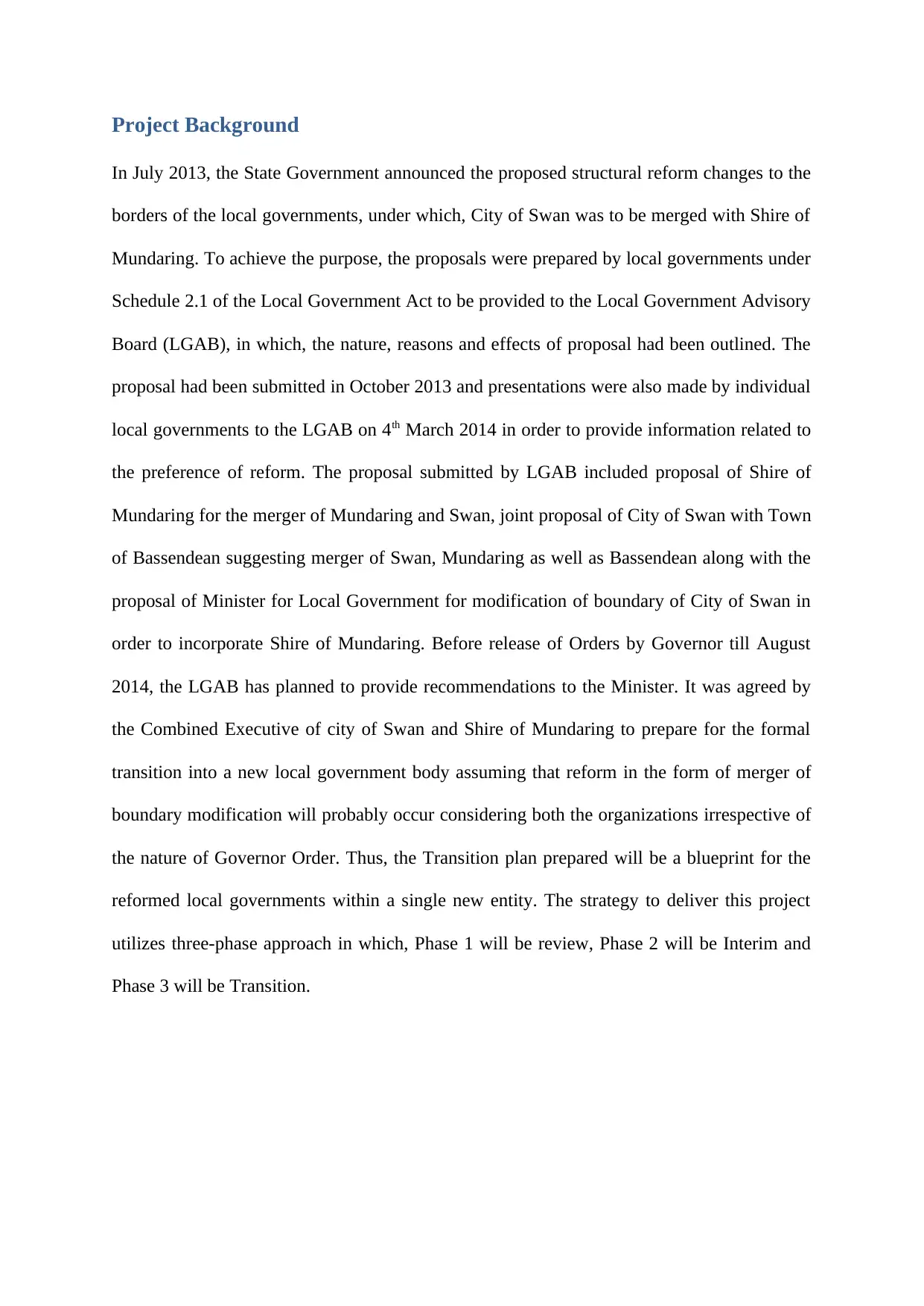
Project Background
In July 2013, the State Government announced the proposed structural reform changes to the
borders of the local governments, under which, City of Swan was to be merged with Shire of
Mundaring. To achieve the purpose, the proposals were prepared by local governments under
Schedule 2.1 of the Local Government Act to be provided to the Local Government Advisory
Board (LGAB), in which, the nature, reasons and effects of proposal had been outlined. The
proposal had been submitted in October 2013 and presentations were also made by individual
local governments to the LGAB on 4th March 2014 in order to provide information related to
the preference of reform. The proposal submitted by LGAB included proposal of Shire of
Mundaring for the merger of Mundaring and Swan, joint proposal of City of Swan with Town
of Bassendean suggesting merger of Swan, Mundaring as well as Bassendean along with the
proposal of Minister for Local Government for modification of boundary of City of Swan in
order to incorporate Shire of Mundaring. Before release of Orders by Governor till August
2014, the LGAB has planned to provide recommendations to the Minister. It was agreed by
the Combined Executive of city of Swan and Shire of Mundaring to prepare for the formal
transition into a new local government body assuming that reform in the form of merger of
boundary modification will probably occur considering both the organizations irrespective of
the nature of Governor Order. Thus, the Transition plan prepared will be a blueprint for the
reformed local governments within a single new entity. The strategy to deliver this project
utilizes three-phase approach in which, Phase 1 will be review, Phase 2 will be Interim and
Phase 3 will be Transition.
In July 2013, the State Government announced the proposed structural reform changes to the
borders of the local governments, under which, City of Swan was to be merged with Shire of
Mundaring. To achieve the purpose, the proposals were prepared by local governments under
Schedule 2.1 of the Local Government Act to be provided to the Local Government Advisory
Board (LGAB), in which, the nature, reasons and effects of proposal had been outlined. The
proposal had been submitted in October 2013 and presentations were also made by individual
local governments to the LGAB on 4th March 2014 in order to provide information related to
the preference of reform. The proposal submitted by LGAB included proposal of Shire of
Mundaring for the merger of Mundaring and Swan, joint proposal of City of Swan with Town
of Bassendean suggesting merger of Swan, Mundaring as well as Bassendean along with the
proposal of Minister for Local Government for modification of boundary of City of Swan in
order to incorporate Shire of Mundaring. Before release of Orders by Governor till August
2014, the LGAB has planned to provide recommendations to the Minister. It was agreed by
the Combined Executive of city of Swan and Shire of Mundaring to prepare for the formal
transition into a new local government body assuming that reform in the form of merger of
boundary modification will probably occur considering both the organizations irrespective of
the nature of Governor Order. Thus, the Transition plan prepared will be a blueprint for the
reformed local governments within a single new entity. The strategy to deliver this project
utilizes three-phase approach in which, Phase 1 will be review, Phase 2 will be Interim and
Phase 3 will be Transition.
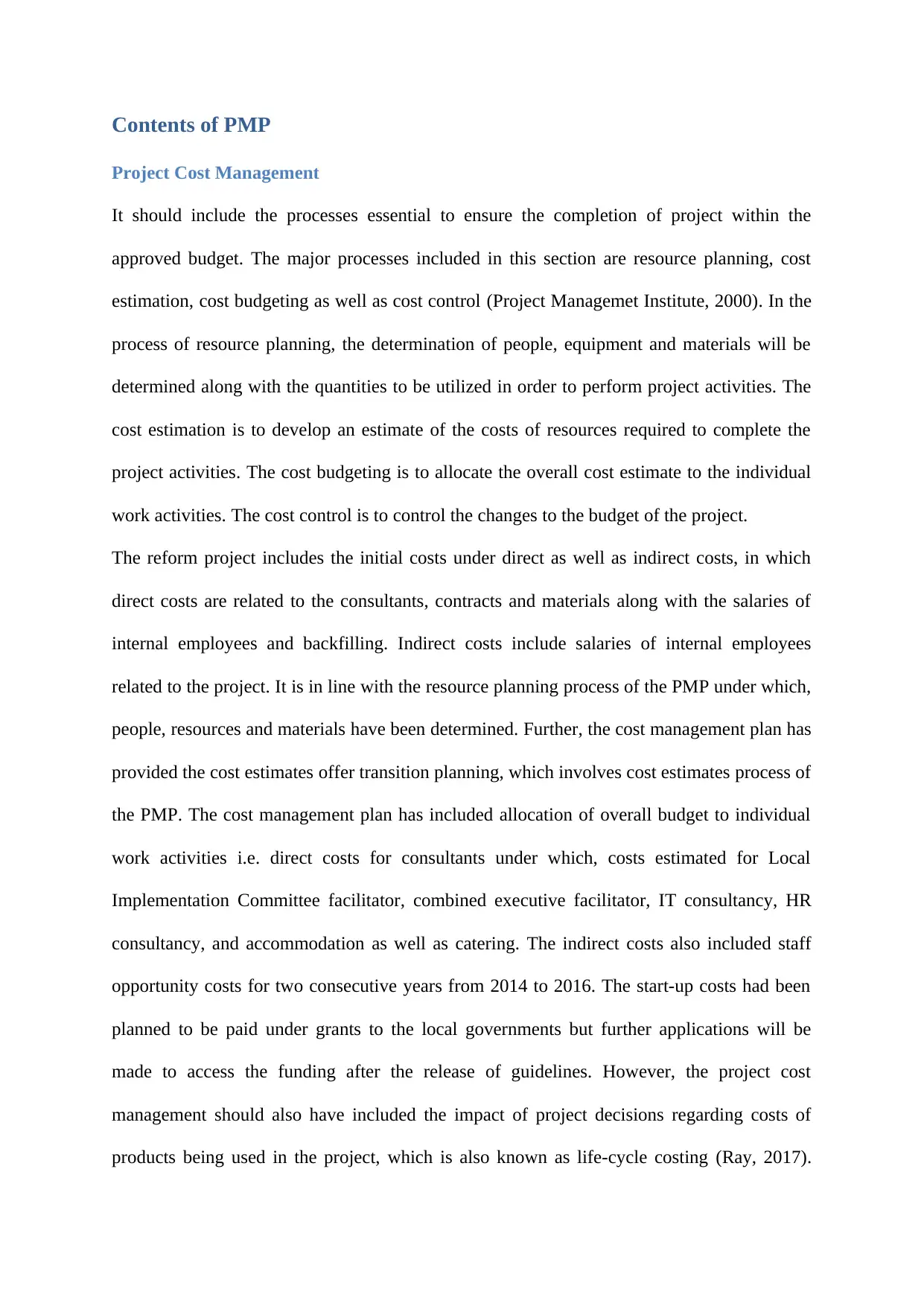
Contents of PMP
Project Cost Management
It should include the processes essential to ensure the completion of project within the
approved budget. The major processes included in this section are resource planning, cost
estimation, cost budgeting as well as cost control (Project Managemet Institute, 2000). In the
process of resource planning, the determination of people, equipment and materials will be
determined along with the quantities to be utilized in order to perform project activities. The
cost estimation is to develop an estimate of the costs of resources required to complete the
project activities. The cost budgeting is to allocate the overall cost estimate to the individual
work activities. The cost control is to control the changes to the budget of the project.
The reform project includes the initial costs under direct as well as indirect costs, in which
direct costs are related to the consultants, contracts and materials along with the salaries of
internal employees and backfilling. Indirect costs include salaries of internal employees
related to the project. It is in line with the resource planning process of the PMP under which,
people, resources and materials have been determined. Further, the cost management plan has
provided the cost estimates offer transition planning, which involves cost estimates process of
the PMP. The cost management plan has included allocation of overall budget to individual
work activities i.e. direct costs for consultants under which, costs estimated for Local
Implementation Committee facilitator, combined executive facilitator, IT consultancy, HR
consultancy, and accommodation as well as catering. The indirect costs also included staff
opportunity costs for two consecutive years from 2014 to 2016. The start-up costs had been
planned to be paid under grants to the local governments but further applications will be
made to access the funding after the release of guidelines. However, the project cost
management should also have included the impact of project decisions regarding costs of
products being used in the project, which is also known as life-cycle costing (Ray, 2017).
Project Cost Management
It should include the processes essential to ensure the completion of project within the
approved budget. The major processes included in this section are resource planning, cost
estimation, cost budgeting as well as cost control (Project Managemet Institute, 2000). In the
process of resource planning, the determination of people, equipment and materials will be
determined along with the quantities to be utilized in order to perform project activities. The
cost estimation is to develop an estimate of the costs of resources required to complete the
project activities. The cost budgeting is to allocate the overall cost estimate to the individual
work activities. The cost control is to control the changes to the budget of the project.
The reform project includes the initial costs under direct as well as indirect costs, in which
direct costs are related to the consultants, contracts and materials along with the salaries of
internal employees and backfilling. Indirect costs include salaries of internal employees
related to the project. It is in line with the resource planning process of the PMP under which,
people, resources and materials have been determined. Further, the cost management plan has
provided the cost estimates offer transition planning, which involves cost estimates process of
the PMP. The cost management plan has included allocation of overall budget to individual
work activities i.e. direct costs for consultants under which, costs estimated for Local
Implementation Committee facilitator, combined executive facilitator, IT consultancy, HR
consultancy, and accommodation as well as catering. The indirect costs also included staff
opportunity costs for two consecutive years from 2014 to 2016. The start-up costs had been
planned to be paid under grants to the local governments but further applications will be
made to access the funding after the release of guidelines. However, the project cost
management should also have included the impact of project decisions regarding costs of
products being used in the project, which is also known as life-cycle costing (Ray, 2017).
⊘ This is a preview!⊘
Do you want full access?
Subscribe today to unlock all pages.

Trusted by 1+ million students worldwide
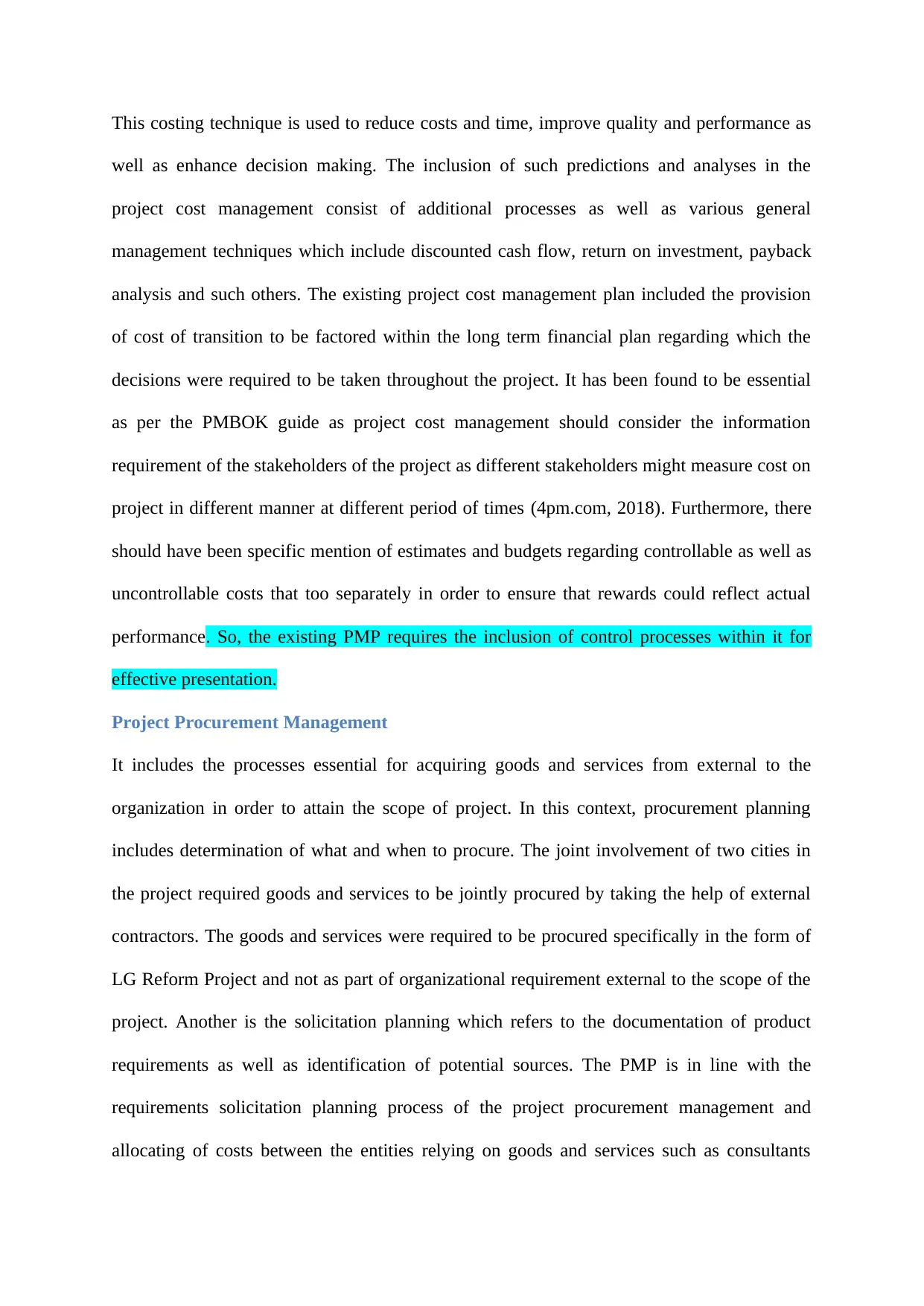
This costing technique is used to reduce costs and time, improve quality and performance as
well as enhance decision making. The inclusion of such predictions and analyses in the
project cost management consist of additional processes as well as various general
management techniques which include discounted cash flow, return on investment, payback
analysis and such others. The existing project cost management plan included the provision
of cost of transition to be factored within the long term financial plan regarding which the
decisions were required to be taken throughout the project. It has been found to be essential
as per the PMBOK guide as project cost management should consider the information
requirement of the stakeholders of the project as different stakeholders might measure cost on
project in different manner at different period of times (4pm.com, 2018). Furthermore, there
should have been specific mention of estimates and budgets regarding controllable as well as
uncontrollable costs that too separately in order to ensure that rewards could reflect actual
performance. So, the existing PMP requires the inclusion of control processes within it for
effective presentation.
Project Procurement Management
It includes the processes essential for acquiring goods and services from external to the
organization in order to attain the scope of project. In this context, procurement planning
includes determination of what and when to procure. The joint involvement of two cities in
the project required goods and services to be jointly procured by taking the help of external
contractors. The goods and services were required to be procured specifically in the form of
LG Reform Project and not as part of organizational requirement external to the scope of the
project. Another is the solicitation planning which refers to the documentation of product
requirements as well as identification of potential sources. The PMP is in line with the
requirements solicitation planning process of the project procurement management and
allocating of costs between the entities relying on goods and services such as consultants
well as enhance decision making. The inclusion of such predictions and analyses in the
project cost management consist of additional processes as well as various general
management techniques which include discounted cash flow, return on investment, payback
analysis and such others. The existing project cost management plan included the provision
of cost of transition to be factored within the long term financial plan regarding which the
decisions were required to be taken throughout the project. It has been found to be essential
as per the PMBOK guide as project cost management should consider the information
requirement of the stakeholders of the project as different stakeholders might measure cost on
project in different manner at different period of times (4pm.com, 2018). Furthermore, there
should have been specific mention of estimates and budgets regarding controllable as well as
uncontrollable costs that too separately in order to ensure that rewards could reflect actual
performance. So, the existing PMP requires the inclusion of control processes within it for
effective presentation.
Project Procurement Management
It includes the processes essential for acquiring goods and services from external to the
organization in order to attain the scope of project. In this context, procurement planning
includes determination of what and when to procure. The joint involvement of two cities in
the project required goods and services to be jointly procured by taking the help of external
contractors. The goods and services were required to be procured specifically in the form of
LG Reform Project and not as part of organizational requirement external to the scope of the
project. Another is the solicitation planning which refers to the documentation of product
requirements as well as identification of potential sources. The PMP is in line with the
requirements solicitation planning process of the project procurement management and
allocating of costs between the entities relying on goods and services such as consultants
Paraphrase This Document
Need a fresh take? Get an instant paraphrase of this document with our AI Paraphraser
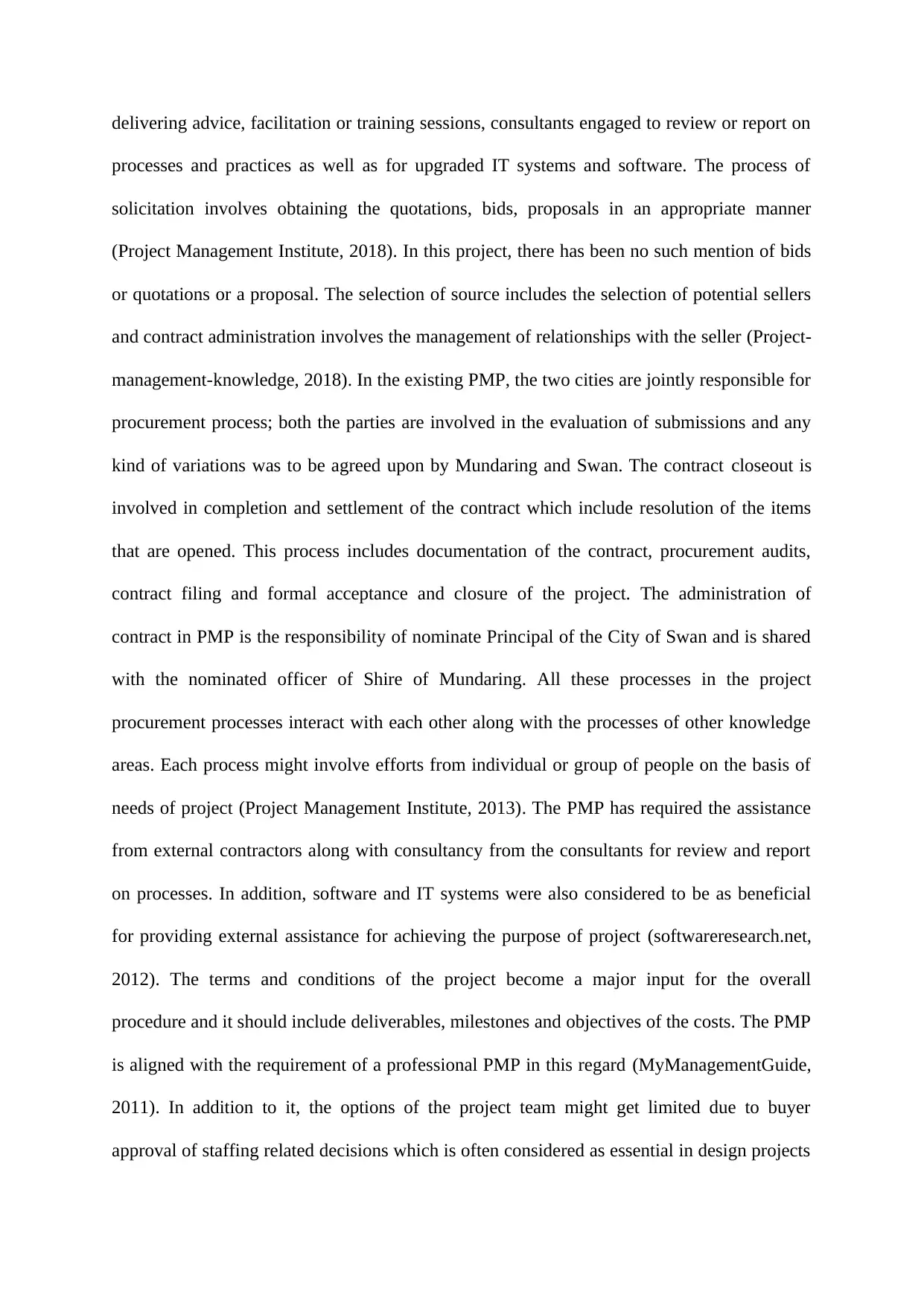
delivering advice, facilitation or training sessions, consultants engaged to review or report on
processes and practices as well as for upgraded IT systems and software. The process of
solicitation involves obtaining the quotations, bids, proposals in an appropriate manner
(Project Management Institute, 2018). In this project, there has been no such mention of bids
or quotations or a proposal. The selection of source includes the selection of potential sellers
and contract administration involves the management of relationships with the seller (Project-
management-knowledge, 2018). In the existing PMP, the two cities are jointly responsible for
procurement process; both the parties are involved in the evaluation of submissions and any
kind of variations was to be agreed upon by Mundaring and Swan. The contract closeout is
involved in completion and settlement of the contract which include resolution of the items
that are opened. This process includes documentation of the contract, procurement audits,
contract filing and formal acceptance and closure of the project. The administration of
contract in PMP is the responsibility of nominate Principal of the City of Swan and is shared
with the nominated officer of Shire of Mundaring. All these processes in the project
procurement processes interact with each other along with the processes of other knowledge
areas. Each process might involve efforts from individual or group of people on the basis of
needs of project (Project Management Institute, 2013). The PMP has required the assistance
from external contractors along with consultancy from the consultants for review and report
on processes. In addition, software and IT systems were also considered to be as beneficial
for providing external assistance for achieving the purpose of project (softwareresearch.net,
2012). The terms and conditions of the project become a major input for the overall
procedure and it should include deliverables, milestones and objectives of the costs. The PMP
is aligned with the requirement of a professional PMP in this regard (MyManagementGuide,
2011). In addition to it, the options of the project team might get limited due to buyer
approval of staffing related decisions which is often considered as essential in design projects
processes and practices as well as for upgraded IT systems and software. The process of
solicitation involves obtaining the quotations, bids, proposals in an appropriate manner
(Project Management Institute, 2018). In this project, there has been no such mention of bids
or quotations or a proposal. The selection of source includes the selection of potential sellers
and contract administration involves the management of relationships with the seller (Project-
management-knowledge, 2018). In the existing PMP, the two cities are jointly responsible for
procurement process; both the parties are involved in the evaluation of submissions and any
kind of variations was to be agreed upon by Mundaring and Swan. The contract closeout is
involved in completion and settlement of the contract which include resolution of the items
that are opened. This process includes documentation of the contract, procurement audits,
contract filing and formal acceptance and closure of the project. The administration of
contract in PMP is the responsibility of nominate Principal of the City of Swan and is shared
with the nominated officer of Shire of Mundaring. All these processes in the project
procurement processes interact with each other along with the processes of other knowledge
areas. Each process might involve efforts from individual or group of people on the basis of
needs of project (Project Management Institute, 2013). The PMP has required the assistance
from external contractors along with consultancy from the consultants for review and report
on processes. In addition, software and IT systems were also considered to be as beneficial
for providing external assistance for achieving the purpose of project (softwareresearch.net,
2012). The terms and conditions of the project become a major input for the overall
procedure and it should include deliverables, milestones and objectives of the costs. The PMP
is aligned with the requirement of a professional PMP in this regard (MyManagementGuide,
2011). In addition to it, the options of the project team might get limited due to buyer
approval of staffing related decisions which is often considered as essential in design projects
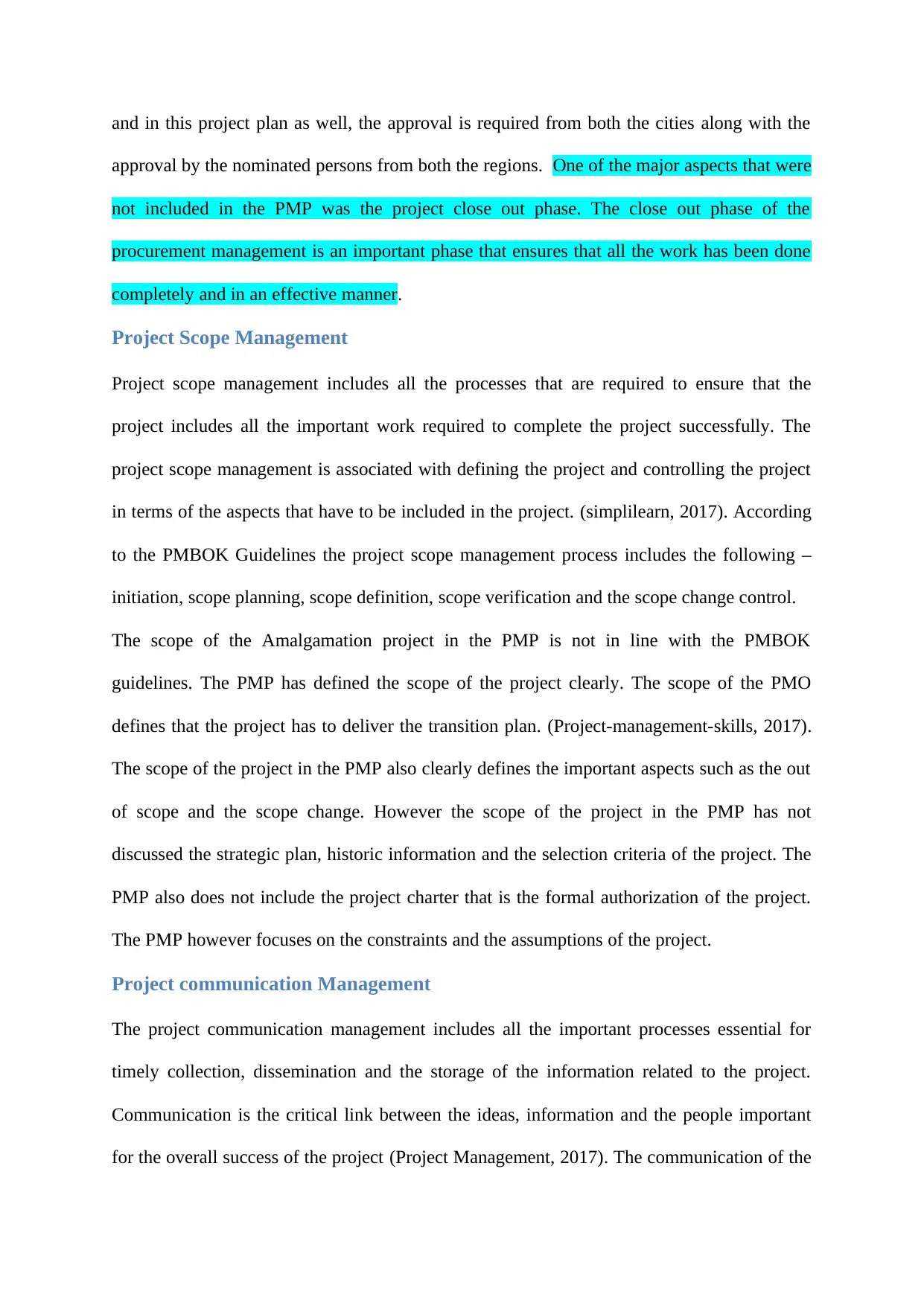
and in this project plan as well, the approval is required from both the cities along with the
approval by the nominated persons from both the regions. One of the major aspects that were
not included in the PMP was the project close out phase. The close out phase of the
procurement management is an important phase that ensures that all the work has been done
completely and in an effective manner.
Project Scope Management
Project scope management includes all the processes that are required to ensure that the
project includes all the important work required to complete the project successfully. The
project scope management is associated with defining the project and controlling the project
in terms of the aspects that have to be included in the project. (simplilearn, 2017). According
to the PMBOK Guidelines the project scope management process includes the following –
initiation, scope planning, scope definition, scope verification and the scope change control.
The scope of the Amalgamation project in the PMP is not in line with the PMBOK
guidelines. The PMP has defined the scope of the project clearly. The scope of the PMO
defines that the project has to deliver the transition plan. (Project-management-skills, 2017).
The scope of the project in the PMP also clearly defines the important aspects such as the out
of scope and the scope change. However the scope of the project in the PMP has not
discussed the strategic plan, historic information and the selection criteria of the project. The
PMP also does not include the project charter that is the formal authorization of the project.
The PMP however focuses on the constraints and the assumptions of the project.
Project communication Management
The project communication management includes all the important processes essential for
timely collection, dissemination and the storage of the information related to the project.
Communication is the critical link between the ideas, information and the people important
for the overall success of the project (Project Management, 2017). The communication of the
approval by the nominated persons from both the regions. One of the major aspects that were
not included in the PMP was the project close out phase. The close out phase of the
procurement management is an important phase that ensures that all the work has been done
completely and in an effective manner.
Project Scope Management
Project scope management includes all the processes that are required to ensure that the
project includes all the important work required to complete the project successfully. The
project scope management is associated with defining the project and controlling the project
in terms of the aspects that have to be included in the project. (simplilearn, 2017). According
to the PMBOK Guidelines the project scope management process includes the following –
initiation, scope planning, scope definition, scope verification and the scope change control.
The scope of the Amalgamation project in the PMP is not in line with the PMBOK
guidelines. The PMP has defined the scope of the project clearly. The scope of the PMO
defines that the project has to deliver the transition plan. (Project-management-skills, 2017).
The scope of the project in the PMP also clearly defines the important aspects such as the out
of scope and the scope change. However the scope of the project in the PMP has not
discussed the strategic plan, historic information and the selection criteria of the project. The
PMP also does not include the project charter that is the formal authorization of the project.
The PMP however focuses on the constraints and the assumptions of the project.
Project communication Management
The project communication management includes all the important processes essential for
timely collection, dissemination and the storage of the information related to the project.
Communication is the critical link between the ideas, information and the people important
for the overall success of the project (Project Management, 2017). The communication of the
⊘ This is a preview!⊘
Do you want full access?
Subscribe today to unlock all pages.

Trusted by 1+ million students worldwide
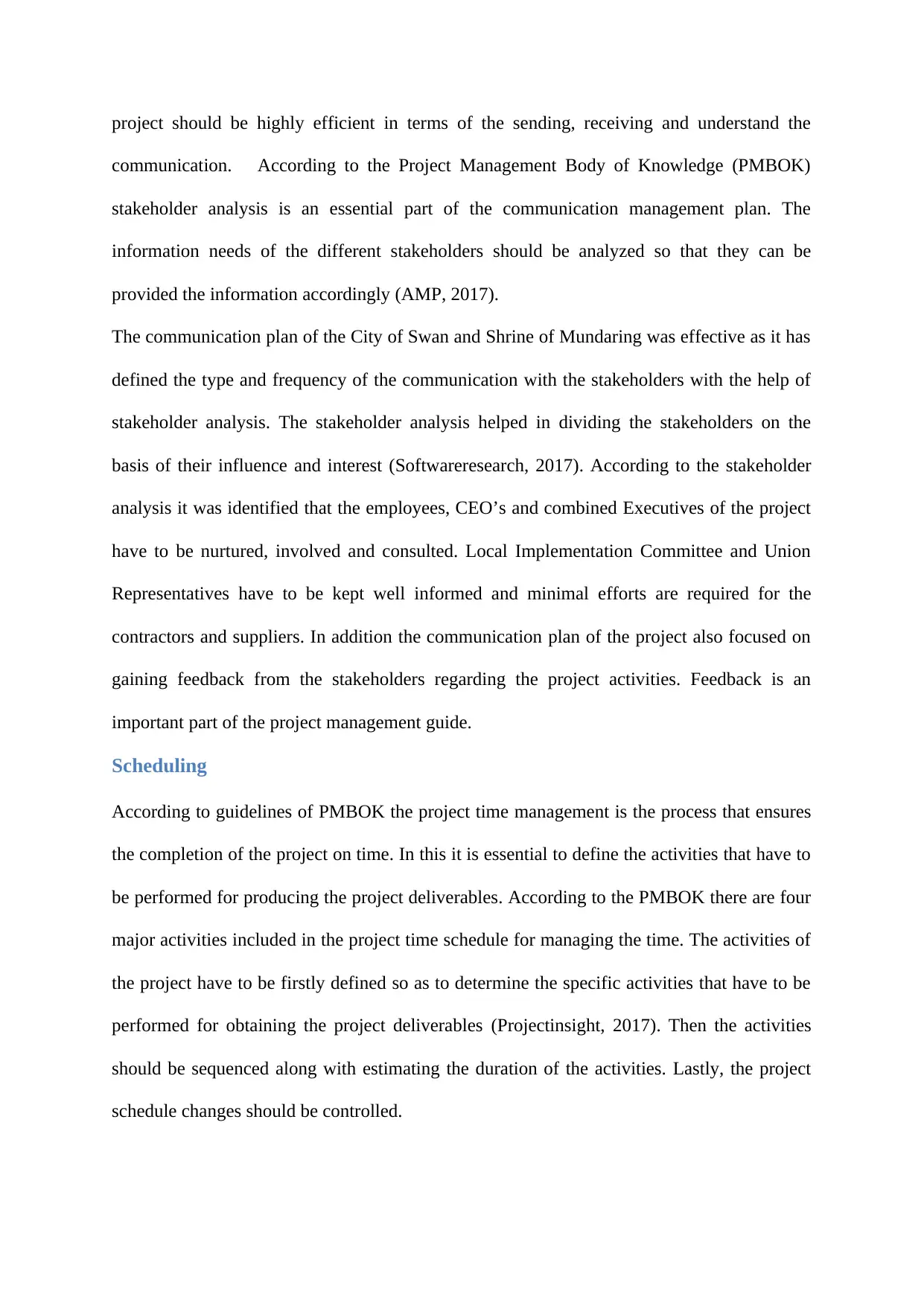
project should be highly efficient in terms of the sending, receiving and understand the
communication. According to the Project Management Body of Knowledge (PMBOK)
stakeholder analysis is an essential part of the communication management plan. The
information needs of the different stakeholders should be analyzed so that they can be
provided the information accordingly (AMP, 2017).
The communication plan of the City of Swan and Shrine of Mundaring was effective as it has
defined the type and frequency of the communication with the stakeholders with the help of
stakeholder analysis. The stakeholder analysis helped in dividing the stakeholders on the
basis of their influence and interest (Softwareresearch, 2017). According to the stakeholder
analysis it was identified that the employees, CEO’s and combined Executives of the project
have to be nurtured, involved and consulted. Local Implementation Committee and Union
Representatives have to be kept well informed and minimal efforts are required for the
contractors and suppliers. In addition the communication plan of the project also focused on
gaining feedback from the stakeholders regarding the project activities. Feedback is an
important part of the project management guide.
Scheduling
According to guidelines of PMBOK the project time management is the process that ensures
the completion of the project on time. In this it is essential to define the activities that have to
be performed for producing the project deliverables. According to the PMBOK there are four
major activities included in the project time schedule for managing the time. The activities of
the project have to be firstly defined so as to determine the specific activities that have to be
performed for obtaining the project deliverables (Projectinsight, 2017). Then the activities
should be sequenced along with estimating the duration of the activities. Lastly, the project
schedule changes should be controlled.
communication. According to the Project Management Body of Knowledge (PMBOK)
stakeholder analysis is an essential part of the communication management plan. The
information needs of the different stakeholders should be analyzed so that they can be
provided the information accordingly (AMP, 2017).
The communication plan of the City of Swan and Shrine of Mundaring was effective as it has
defined the type and frequency of the communication with the stakeholders with the help of
stakeholder analysis. The stakeholder analysis helped in dividing the stakeholders on the
basis of their influence and interest (Softwareresearch, 2017). According to the stakeholder
analysis it was identified that the employees, CEO’s and combined Executives of the project
have to be nurtured, involved and consulted. Local Implementation Committee and Union
Representatives have to be kept well informed and minimal efforts are required for the
contractors and suppliers. In addition the communication plan of the project also focused on
gaining feedback from the stakeholders regarding the project activities. Feedback is an
important part of the project management guide.
Scheduling
According to guidelines of PMBOK the project time management is the process that ensures
the completion of the project on time. In this it is essential to define the activities that have to
be performed for producing the project deliverables. According to the PMBOK there are four
major activities included in the project time schedule for managing the time. The activities of
the project have to be firstly defined so as to determine the specific activities that have to be
performed for obtaining the project deliverables (Projectinsight, 2017). Then the activities
should be sequenced along with estimating the duration of the activities. Lastly, the project
schedule changes should be controlled.
Paraphrase This Document
Need a fresh take? Get an instant paraphrase of this document with our AI Paraphraser
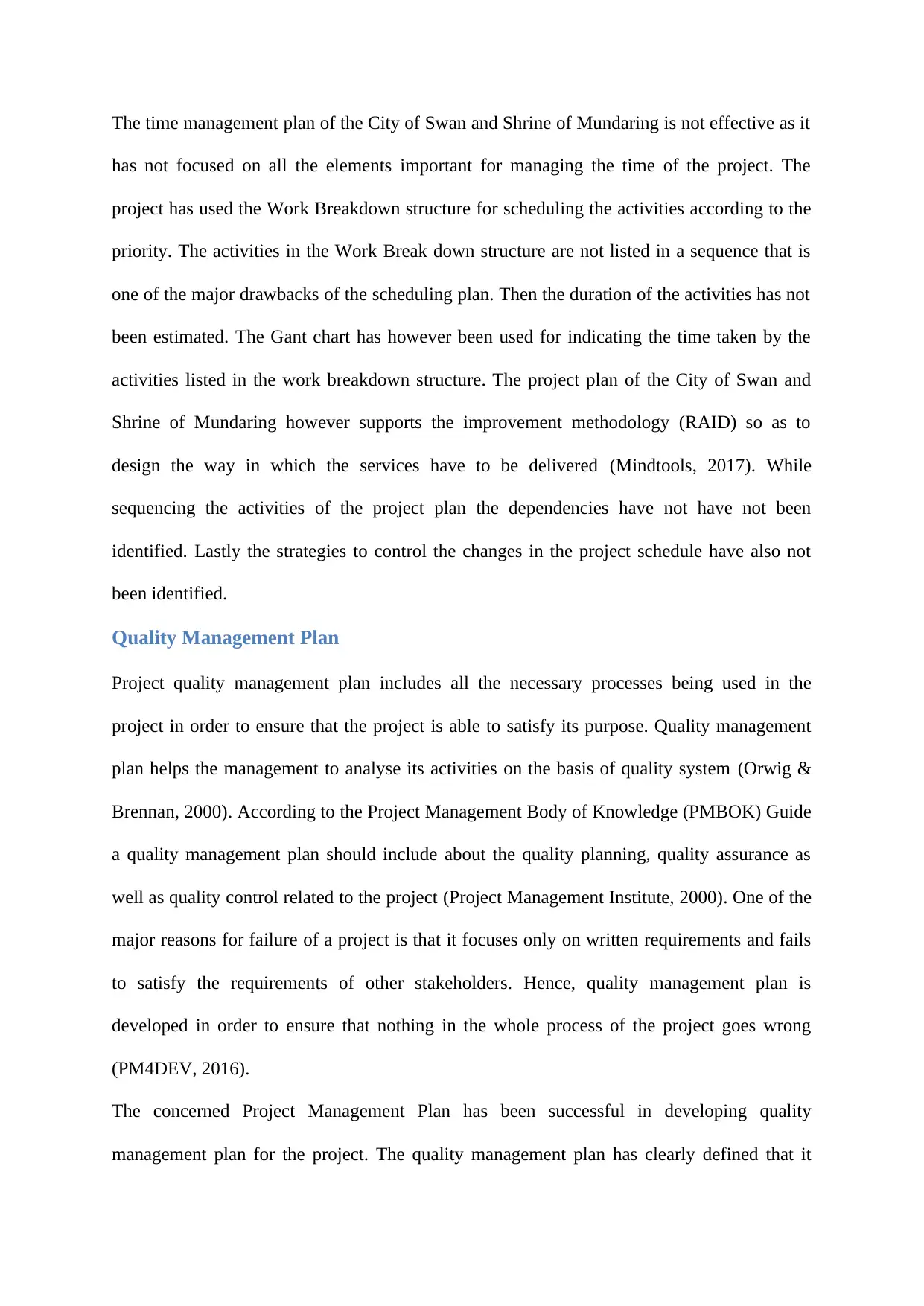
The time management plan of the City of Swan and Shrine of Mundaring is not effective as it
has not focused on all the elements important for managing the time of the project. The
project has used the Work Breakdown structure for scheduling the activities according to the
priority. The activities in the Work Break down structure are not listed in a sequence that is
one of the major drawbacks of the scheduling plan. Then the duration of the activities has not
been estimated. The Gant chart has however been used for indicating the time taken by the
activities listed in the work breakdown structure. The project plan of the City of Swan and
Shrine of Mundaring however supports the improvement methodology (RAID) so as to
design the way in which the services have to be delivered (Mindtools, 2017). While
sequencing the activities of the project plan the dependencies have not have not been
identified. Lastly the strategies to control the changes in the project schedule have also not
been identified.
Quality Management Plan
Project quality management plan includes all the necessary processes being used in the
project in order to ensure that the project is able to satisfy its purpose. Quality management
plan helps the management to analyse its activities on the basis of quality system (Orwig &
Brennan, 2000). According to the Project Management Body of Knowledge (PMBOK) Guide
a quality management plan should include about the quality planning, quality assurance as
well as quality control related to the project (Project Management Institute, 2000). One of the
major reasons for failure of a project is that it focuses only on written requirements and fails
to satisfy the requirements of other stakeholders. Hence, quality management plan is
developed in order to ensure that nothing in the whole process of the project goes wrong
(PM4DEV, 2016).
The concerned Project Management Plan has been successful in developing quality
management plan for the project. The quality management plan has clearly defined that it
has not focused on all the elements important for managing the time of the project. The
project has used the Work Breakdown structure for scheduling the activities according to the
priority. The activities in the Work Break down structure are not listed in a sequence that is
one of the major drawbacks of the scheduling plan. Then the duration of the activities has not
been estimated. The Gant chart has however been used for indicating the time taken by the
activities listed in the work breakdown structure. The project plan of the City of Swan and
Shrine of Mundaring however supports the improvement methodology (RAID) so as to
design the way in which the services have to be delivered (Mindtools, 2017). While
sequencing the activities of the project plan the dependencies have not have not been
identified. Lastly the strategies to control the changes in the project schedule have also not
been identified.
Quality Management Plan
Project quality management plan includes all the necessary processes being used in the
project in order to ensure that the project is able to satisfy its purpose. Quality management
plan helps the management to analyse its activities on the basis of quality system (Orwig &
Brennan, 2000). According to the Project Management Body of Knowledge (PMBOK) Guide
a quality management plan should include about the quality planning, quality assurance as
well as quality control related to the project (Project Management Institute, 2000). One of the
major reasons for failure of a project is that it focuses only on written requirements and fails
to satisfy the requirements of other stakeholders. Hence, quality management plan is
developed in order to ensure that nothing in the whole process of the project goes wrong
(PM4DEV, 2016).
The concerned Project Management Plan has been successful in developing quality
management plan for the project. The quality management plan has clearly defined that it
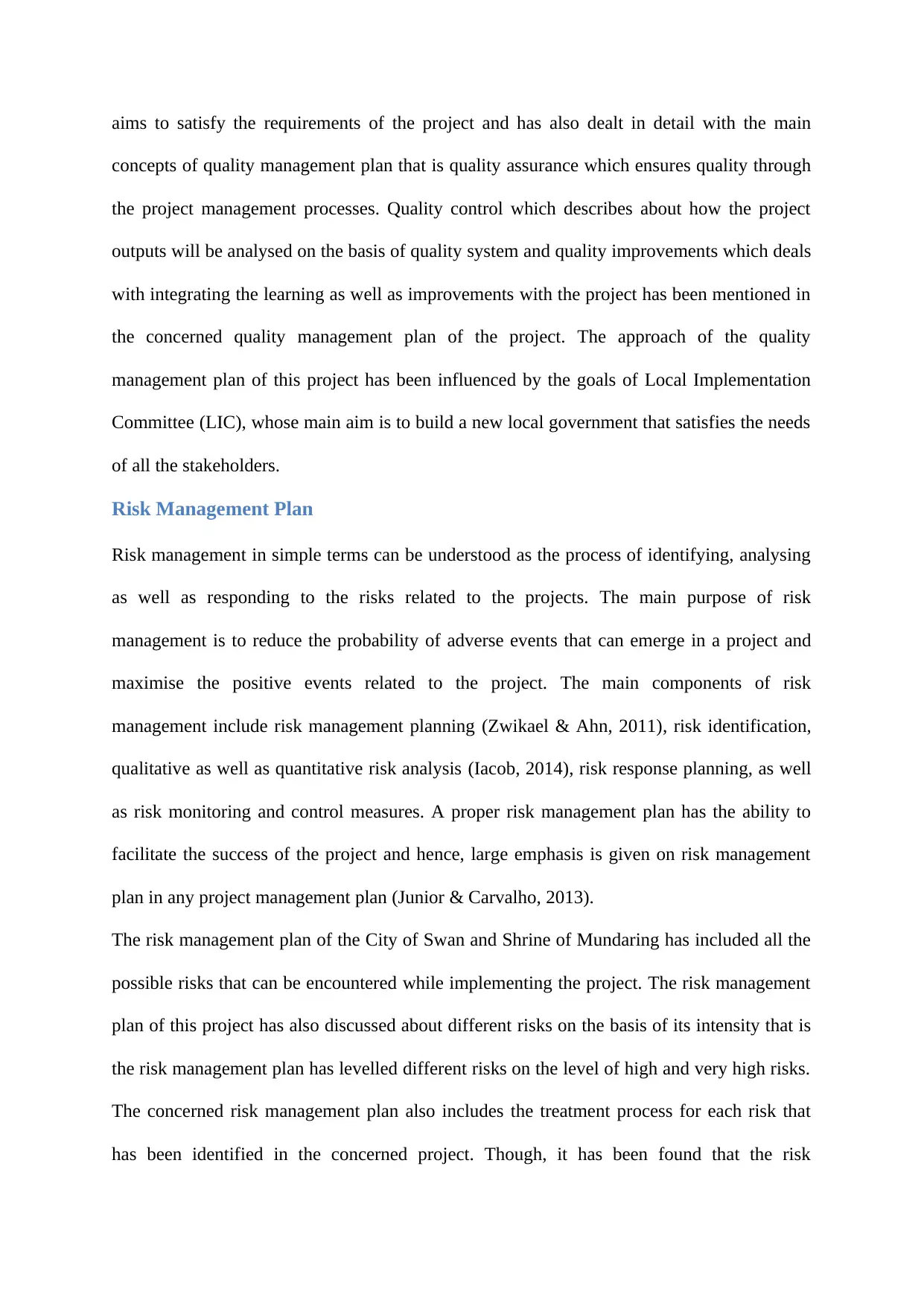
aims to satisfy the requirements of the project and has also dealt in detail with the main
concepts of quality management plan that is quality assurance which ensures quality through
the project management processes. Quality control which describes about how the project
outputs will be analysed on the basis of quality system and quality improvements which deals
with integrating the learning as well as improvements with the project has been mentioned in
the concerned quality management plan of the project. The approach of the quality
management plan of this project has been influenced by the goals of Local Implementation
Committee (LIC), whose main aim is to build a new local government that satisfies the needs
of all the stakeholders.
Risk Management Plan
Risk management in simple terms can be understood as the process of identifying, analysing
as well as responding to the risks related to the projects. The main purpose of risk
management is to reduce the probability of adverse events that can emerge in a project and
maximise the positive events related to the project. The main components of risk
management include risk management planning (Zwikael & Ahn, 2011), risk identification,
qualitative as well as quantitative risk analysis (Iacob, 2014), risk response planning, as well
as risk monitoring and control measures. A proper risk management plan has the ability to
facilitate the success of the project and hence, large emphasis is given on risk management
plan in any project management plan (Junior & Carvalho, 2013).
The risk management plan of the City of Swan and Shrine of Mundaring has included all the
possible risks that can be encountered while implementing the project. The risk management
plan of this project has also discussed about different risks on the basis of its intensity that is
the risk management plan has levelled different risks on the level of high and very high risks.
The concerned risk management plan also includes the treatment process for each risk that
has been identified in the concerned project. Though, it has been found that the risk
concepts of quality management plan that is quality assurance which ensures quality through
the project management processes. Quality control which describes about how the project
outputs will be analysed on the basis of quality system and quality improvements which deals
with integrating the learning as well as improvements with the project has been mentioned in
the concerned quality management plan of the project. The approach of the quality
management plan of this project has been influenced by the goals of Local Implementation
Committee (LIC), whose main aim is to build a new local government that satisfies the needs
of all the stakeholders.
Risk Management Plan
Risk management in simple terms can be understood as the process of identifying, analysing
as well as responding to the risks related to the projects. The main purpose of risk
management is to reduce the probability of adverse events that can emerge in a project and
maximise the positive events related to the project. The main components of risk
management include risk management planning (Zwikael & Ahn, 2011), risk identification,
qualitative as well as quantitative risk analysis (Iacob, 2014), risk response planning, as well
as risk monitoring and control measures. A proper risk management plan has the ability to
facilitate the success of the project and hence, large emphasis is given on risk management
plan in any project management plan (Junior & Carvalho, 2013).
The risk management plan of the City of Swan and Shrine of Mundaring has included all the
possible risks that can be encountered while implementing the project. The risk management
plan of this project has also discussed about different risks on the basis of its intensity that is
the risk management plan has levelled different risks on the level of high and very high risks.
The concerned risk management plan also includes the treatment process for each risk that
has been identified in the concerned project. Though, it has been found that the risk
⊘ This is a preview!⊘
Do you want full access?
Subscribe today to unlock all pages.

Trusted by 1+ million students worldwide
1 out of 18
Related Documents
Your All-in-One AI-Powered Toolkit for Academic Success.
+13062052269
info@desklib.com
Available 24*7 on WhatsApp / Email
![[object Object]](/_next/static/media/star-bottom.7253800d.svg)
Unlock your academic potential
Copyright © 2020–2025 A2Z Services. All Rights Reserved. Developed and managed by ZUCOL.




